The Cambridge History of China. Vol. 13: Republican China 1912-1949, Part 2
Подождите немного. Документ загружается.

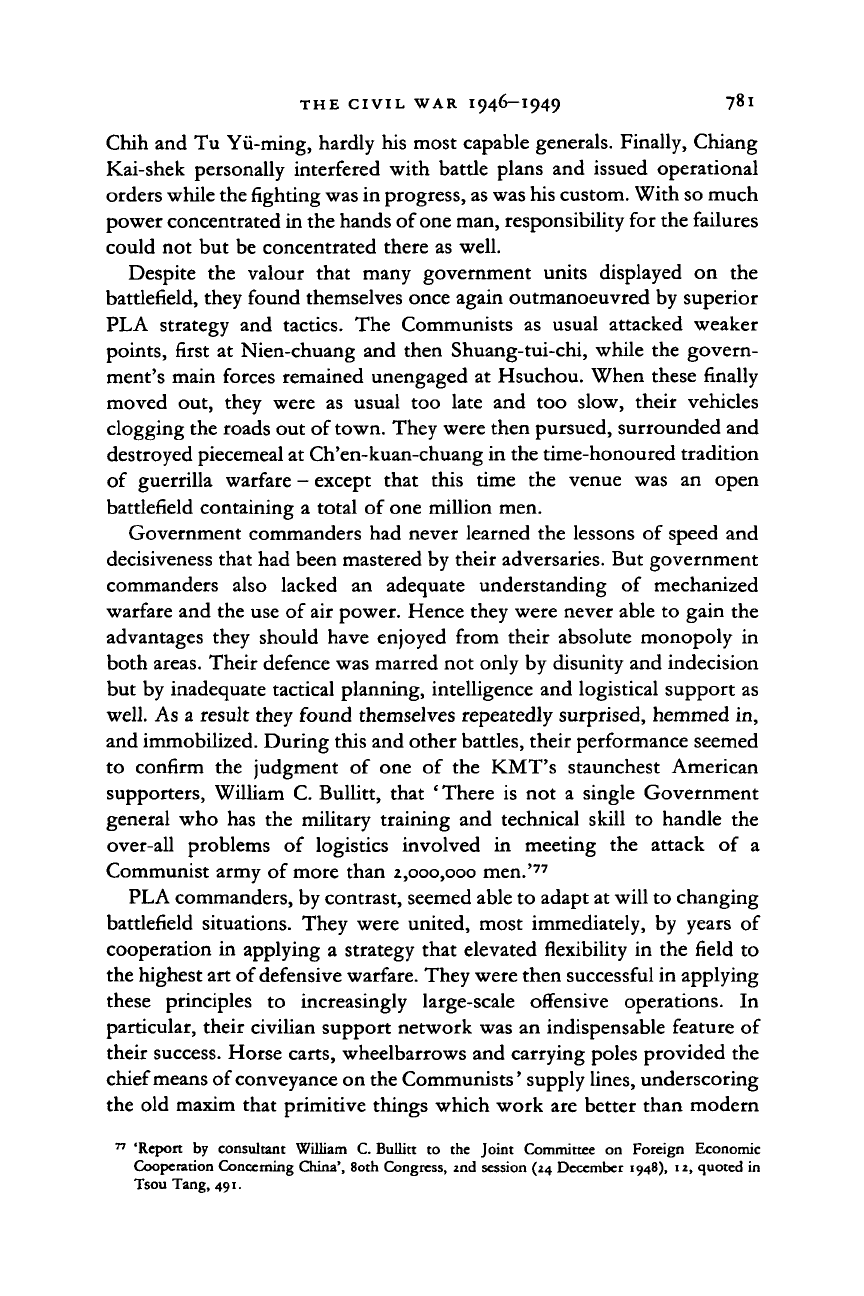
THE CIVIL WAR I946-I949 7^1
Chih and Tu Yu-ming, hardly his most capable generals. Finally, Chiang
Kai-shek personally interfered with battle plans and issued operational
orders while the fighting was in progress, as was his custom. With so much
power concentrated in the hands of one man, responsibility for the failures
could not but be concentrated there as well.
Despite
the
valour that many government units displayed
on the
battlefield, they found themselves once again outmanoeuvred by superior
PLA strategy
and
tactics.
The
Communists
as
usual attacked weaker
points, first
at
Nien-chuang and then Shuang-tui-chi, while the govern-
ment's main forces remained unengaged
at
Hsuchou. When these finally
moved out, they were
as
usual
too
late
and too
slow, their vehicles
clogging the roads out of
town.
They were then pursued, surrounded and
destroyed piecemeal at Ch'en-kuan-chuang in the time-honoured tradition
of guerrilla warfare
—
except that this time
the
venue
was an
open
battlefield containing
a
total of one million men.
Government commanders had never learned the lessons
of
speed and
decisiveness that had been mastered by their adversaries. But government
commanders also lacked
an
adequate understanding
of
mechanized
warfare and the use of air power. Hence they were never able to gain the
advantages they should have enjoyed from their absolute monopoly
in
both areas. Their defence was marred not only by disunity and indecision
but by inadequate tactical planning, intelligence and logistical support as
well. As a result they found themselves repeatedly surprised, hemmed in,
and immobilized. During this and other battles, their performance seemed
to confirm
the
judgment
of
one
of
the KMT's staunchest American
supporters, William C. Bullitt, that 'There
is
not
a
single Government
general who has the military training and technical skill
to
handle
the
over-all problems
of
logistics involved
in
meeting
the
attack
of a
Communist army of more than 2,000,000 men.'
77
PLA commanders, by contrast, seemed able to adapt at will to changing
battlefield situations. They were united, most immediately,
by
years
of
cooperation in applying
a
strategy that elevated flexibility
in
the field
to
the highest art of defensive warfare. They were then successful in applying
these principles
to
increasingly large-scale offensive operations.
In
particular, their civilian support network was an indispensable feature of
their success. Horse carts, wheelbarrows and carrying poles provided the
chief means of conveyance on the Communists' supply lines, underscoring
the old maxim that primitive things which work are better than modern
77
'Report
by
consultant William C. Bullitt
to the
Joint Committee
on
Foreign Economic
Cooperation Concerning China', 8oth Congress, 2nd session (24 December 1948), 12, quoted in
Tsou Tang, 491.
Cambridge Histories Online © Cambridge University Press, 2008
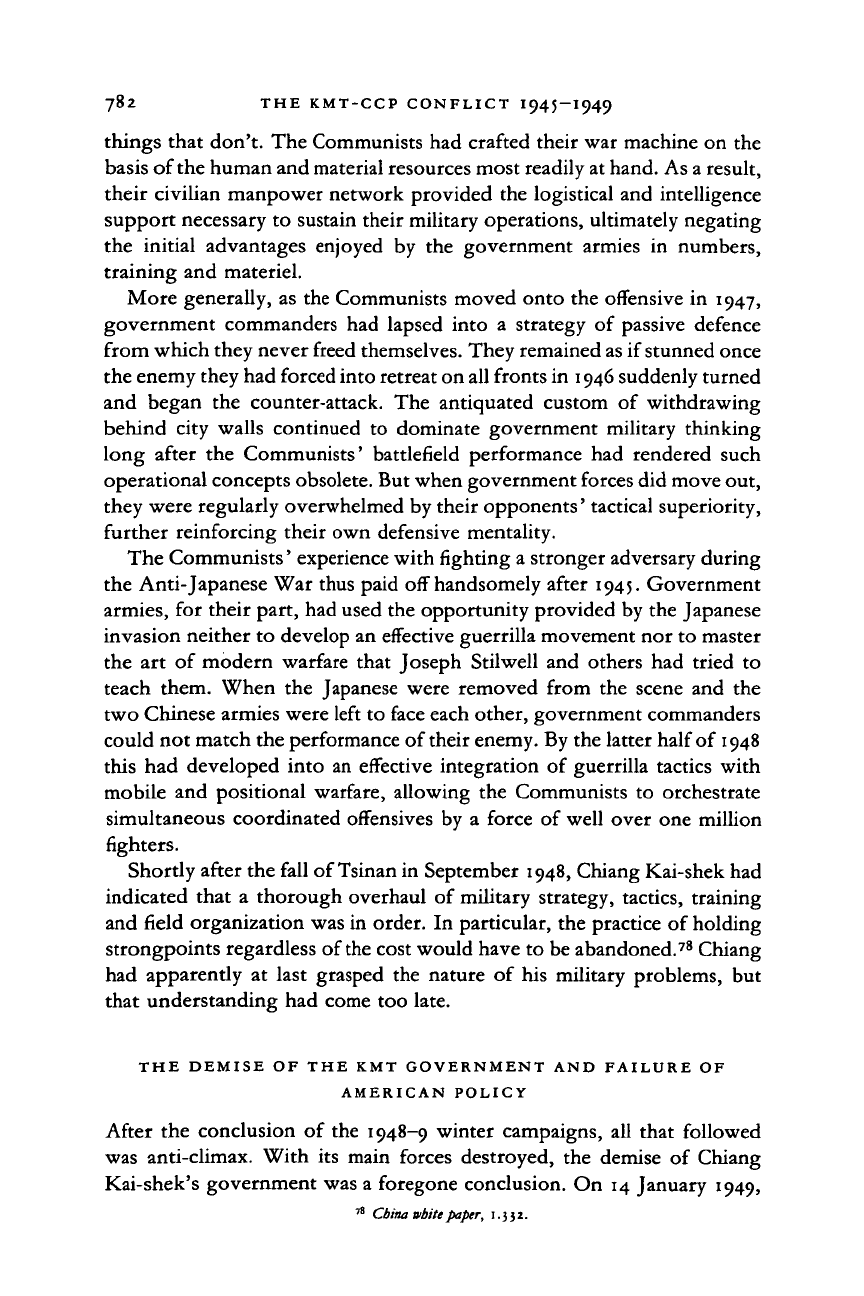
782 THE KMT-CCP CONFLICT I945-I949
things that don't. The Communists had crafted their war machine on the
basis of the human and material resources most readily at hand. As a result,
their civilian manpower network provided the logistical and intelligence
support necessary to sustain their military operations, ultimately negating
the initial advantages enjoyed by the government armies
in
numbers,
training and materiel.
More generally, as the Communists moved onto the offensive in 1947,
government commanders had lapsed into
a
strategy of passive defence
from which they never freed themselves. They remained as if stunned once
the enemy they had forced into retreat on all fronts in 1946 suddenly turned
and began the counter-attack. The antiquated custom
of
withdrawing
behind city walls continued
to
dominate government military thinking
long after the Communists' battlefield performance had rendered such
operational concepts obsolete. But when government forces did move out,
they were regularly overwhelmed by their opponents' tactical superiority,
further reinforcing their own defensive mentality.
The Communists' experience with fighting a stronger adversary during
the Anti-Japanese War thus paid off handsomely after 1945. Government
armies, for their part, had used the opportunity provided by the Japanese
invasion neither to develop an effective guerrilla movement nor to master
the art of modern warfare that Joseph Stilwell and others had tried
to
teach them. When the Japanese were removed from the scene and the
two Chinese armies were left to face each other, government commanders
could not match the performance of their enemy. By the latter half of 1948
this had developed into an effective integration of guerrilla tactics with
mobile and positional warfare, allowing the Communists to orchestrate
simultaneous coordinated offensives by
a
force of well over one million
fighters.
Shortly after the fall of Tsinan in September 1948, Chiang Kai-shek had
indicated that
a
thorough overhaul of military strategy, tactics, training
and field organization was in order. In particular, the practice of holding
strongpoints regardless of
the
cost would have to be abandoned.
78
Chiang
had apparently
at
last grasped the nature
of
his military problems, but
that understanding had come too late.
THE DEMISE
OF THE KMT
GOVERNMENT
AND
FAILURE
OF
AMERICAN POLICY
After the conclusion of the 1948-9 winter campaigns, all that followed
was anti-climax. With its main forces destroyed, the demise
of
Chiang
Kai-shek's government was a foregone conclusion. On 14 January 1949,
78
China wbitt paper, 1.332.
Cambridge Histories Online © Cambridge University Press, 2008
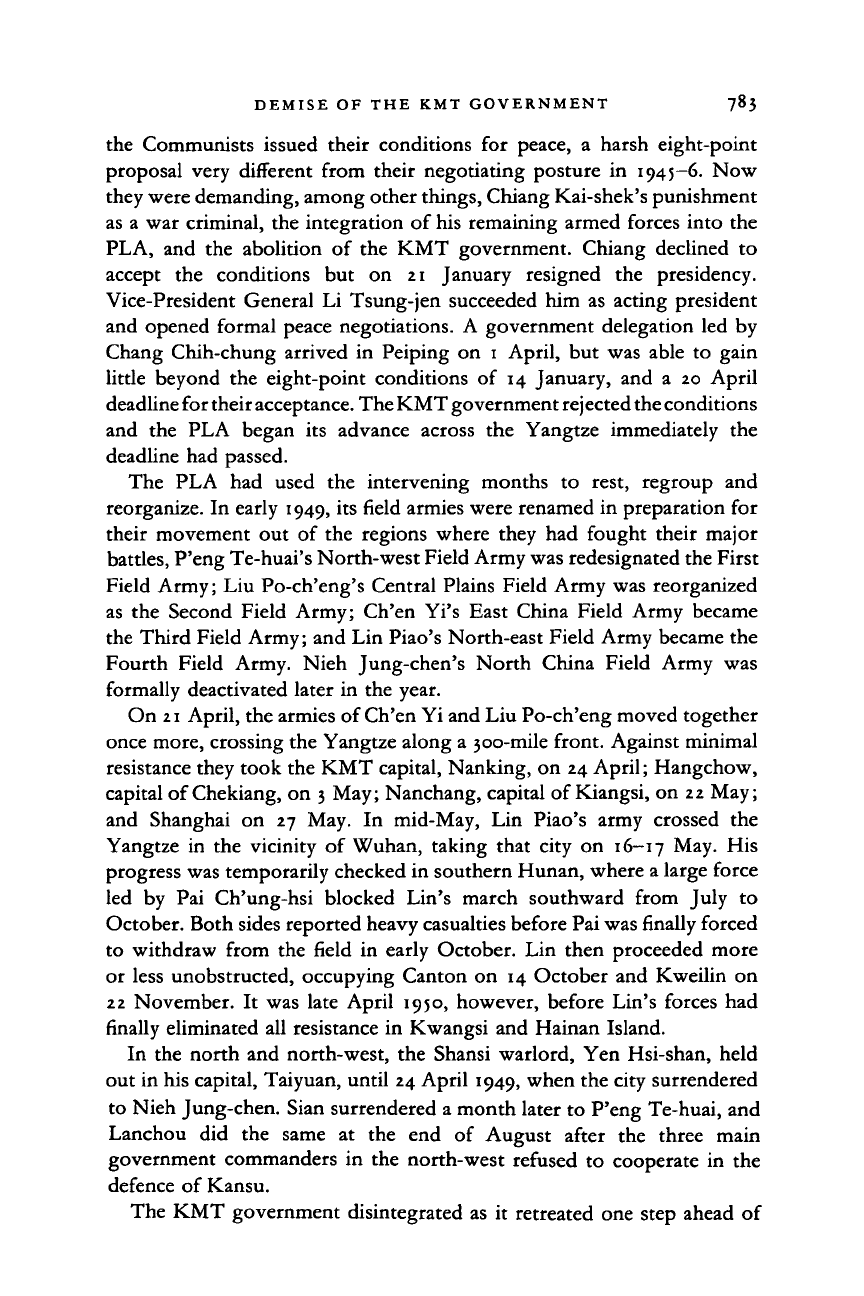
DEMISE OF THE KMT GOVERNMENT 783
the Communists issued their conditions for peace, a harsh eight-point
proposal very different from their negotiating posture in 1945-6. Now
they were demanding, among other things, Chiang Kai-shek's punishment
as a war criminal, the integration of his remaining armed forces into the
PLA, and the abolition of the KMT government. Chiang declined to
accept the conditions but on 21 January resigned the presidency.
Vice-President General Li Tsung-jen succeeded him as acting president
and opened formal peace negotiations. A government delegation led by
Chang Chih-chung arrived in Peiping on 1 April, but was able to gain
little beyond the eight-point conditions of 14 January, and a 20 April
deadline for their acceptance. The KMT government rejected
the
conditions
and the PLA began its advance across the Yangtze immediately the
deadline had passed.
The PLA had used the intervening months to rest, regroup and
reorganize. In early 1949, its field armies were renamed in preparation for
their movement out of the regions where they had fought their major
battles, P'eng Te-huai's North-west Field Army was redesignated the First
Field Army; Liu Po-ch'eng's Central Plains Field Army was reorganized
as the Second Field Army; Ch'en Yi's East China Field Army became
the Third Field Army; and Lin Piao's North-east Field Army became the
Fourth Field Army. Nieh Jung-chen's North China Field Army was
formally deactivated later in the year.
On
21
April, the armies of Ch'en Yi and Liu Po-ch'eng moved together
once more, crossing the Yangtze along a 300-mile front. Against minimal
resistance they took the KMT capital, Nanking, on 24 April; Hangchow,
capital of Chekiang, on
3
May; Nanchang, capital of Kiangsi, on 22 May;
and Shanghai on 27 May. In mid-May, Lin Piao's army crossed the
Yangtze in the vicinity of Wuhan, taking that city on 16-17 May. His
progress was temporarily checked in southern Hunan, where a large force
led by Pai Ch'ung-hsi blocked Lin's march southward from July to
October. Both sides reported heavy casualties before Pai was finally forced
to withdraw from the field in early October. Lin then proceeded more
or less unobstructed, occupying Canton on 14 October and Kweilin on
22 November. It was late April 1950, however, before Lin's forces had
finally eliminated all resistance in Kwangsi and Hainan Island.
In the north and north-west, the Shansi warlord, Yen Hsi-shan, held
out in his capital, Taiyuan, until 24 April 1949, when the city surrendered
to Nieh Jung-chen. Sian surrendered a month later to P'eng Te-huai, and
Lanchou did the same at the end of August after the three main
government commanders in the north-west refused to cooperate in the
defence of Kansu.
The KMT government disintegrated as it retreated one step ahead of
Cambridge Histories Online © Cambridge University Press, 2008
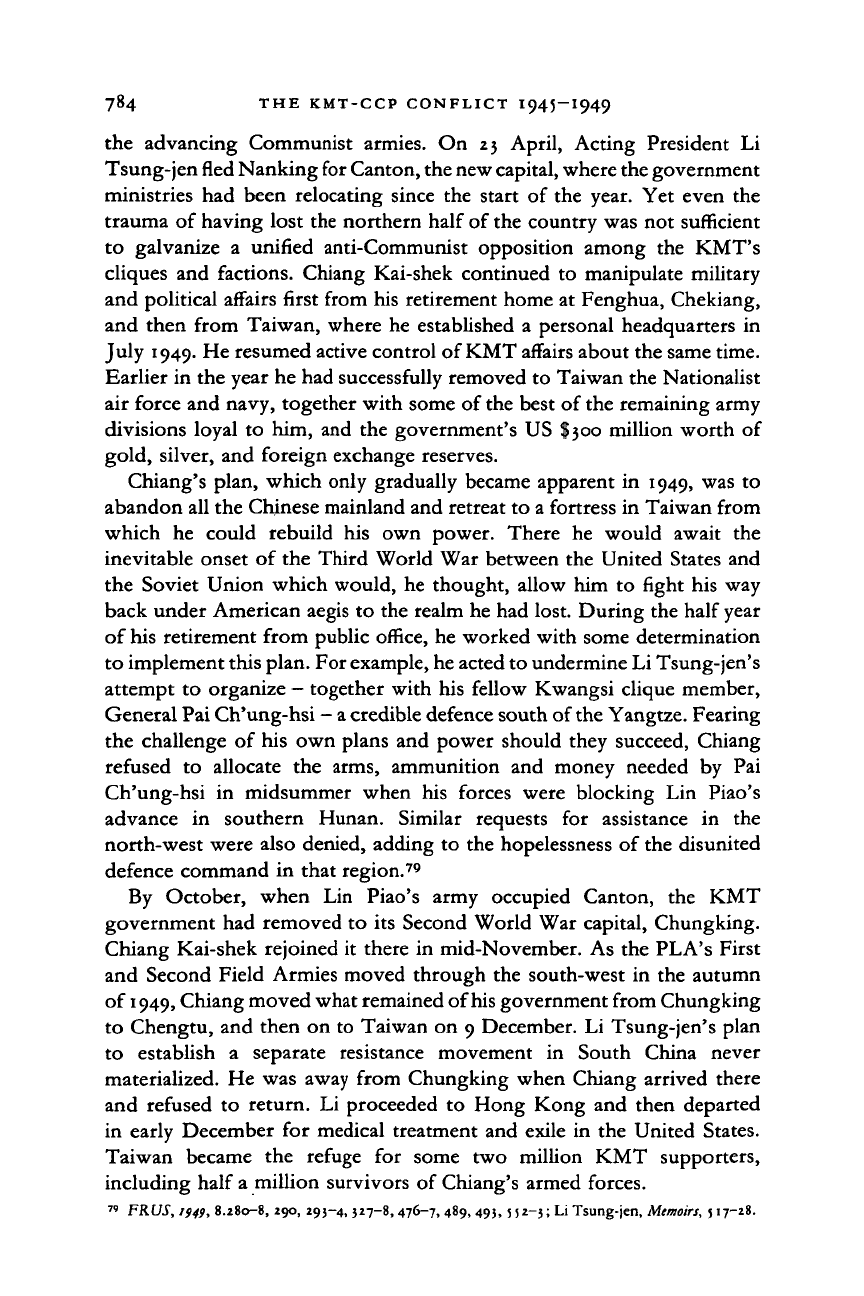
784 THE KMT-CCP CONFLICT I945-I949
the advancing Communist armies. On 23 April, Acting President Li
Tsung-jen fled Nanking for Canton, the new
capital,
where the government
ministries had been relocating since the start of the year. Yet even the
trauma of having lost the northern half of the country was not sufficient
to galvanize
a
unified anti-Communist opposition among the KMT's
cliques and factions. Chiang Kai-shek continued to manipulate military
and political affairs first from his retirement home at Fenghua, Chekiang,
and then from Taiwan, where he established a personal headquarters in
July 1949. He resumed active control of KMT affairs about the same time.
Earlier in the year he had successfully removed to Taiwan the Nationalist
air force and navy, together with some of the best of the remaining army
divisions loyal to him, and the government's US $300 million worth of
gold, silver, and foreign exchange reserves.
Chiang's plan, which only gradually became apparent in 1949, was to
abandon all the Chinese mainland and retreat to a fortress in Taiwan from
which
he
could rebuild his own power. There he would await the
inevitable onset of the Third World War between the United States and
the Soviet Union which would, he thought, allow him to fight his way
back under American aegis to the realm he had lost. During the half year
of his retirement from public office, he worked with some determination
to implement this plan. For example, he acted to undermine Li Tsung-jen's
attempt to organize
-
together with his fellow Kwangsi clique member,
General Pai Ch'ung-hsi
-
a
credible defence south of the Yangtze. Fearing
the challenge of his own plans and power should they succeed, Chiang
refused
to
allocate the arms, ammunition and money needed by Pai
Ch'ung-hsi
in
midsummer when his forces were blocking Lin Piao's
advance
in
southern Hunan. Similar requests
for
assistance
in the
north-west were also denied, adding to the hopelessness of the disunited
defence command in that region.
79
By October, when Lin Piao's army occupied Canton, the KMT
government had removed to its Second World War capital, Chungking.
Chiang Kai-shek rejoined it there in mid-November. As the PLA's First
and Second Field Armies moved through the south-west in the autumn
of
1949,
Chiang moved what remained of his government from Chungking
to Chengtu, and then on to Taiwan on 9 December. Li Tsung-jen's plan
to establish
a
separate resistance movement
in
South China never
materialized. He was away from Chungking when Chiang arrived there
and refused to return. Li proceeded to Hong Kong and then departed
in early December for medical treatment and exile in the United States.
Taiwan became the refuge
for
some two million KMT supporters,
including half a million survivors of Chiang's armed forces.
™ FRUS, if49, 8.280-8, 290, 293—4, 327-8, 476—7, 489, 493, 552-3; Li Tsung-jen, Memoirs, 517-28.
Cambridge Histories Online © Cambridge University Press, 2008
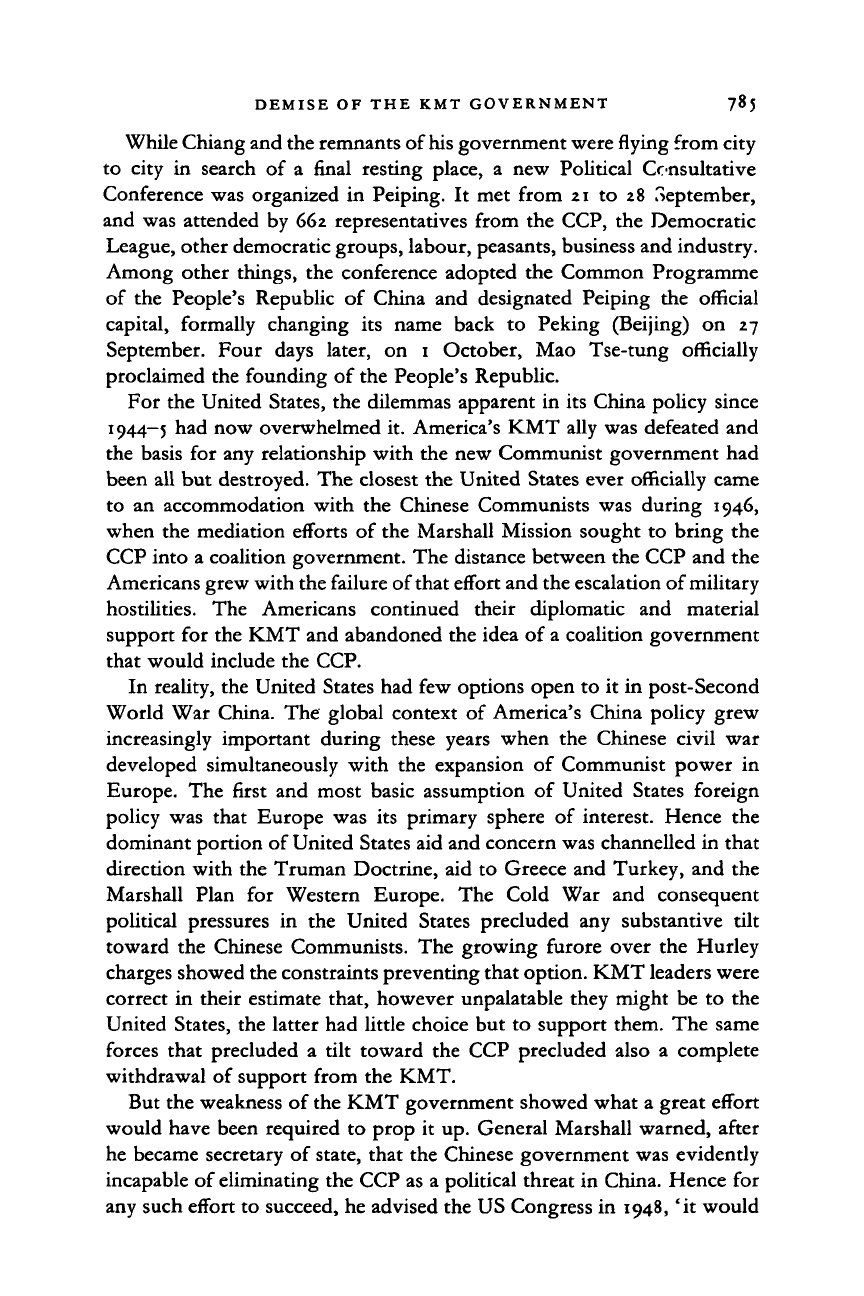
DEMISE OF THE KMT GOVERNMENT 785
While Chiang and the remnants of his government were flying from city
to city in search of a final resting place, a new Political Consultative
Conference was organized in Peiping. It met from 21 to 28 September,
and was attended by 662 representatives from the CCP, the Democratic
League, other democratic groups, labour, peasants, business and industry.
Among other things, the conference adopted the Common Programme
of the People's Republic of China and designated Peiping the official
capital, formally changing its name back to Peking (Beijing) on 27
September. Four days later, on 1 October, Mao Tse-tung officially
proclaimed the founding of the People's Republic.
For the United States, the dilemmas apparent in its China policy since
1944-5 had now overwhelmed it. America's KMT ally was defeated and
the basis for any relationship with the new Communist government had
been all but destroyed. The closest the United States ever officially came
to an accommodation with the Chinese Communists was during 1946,
when the mediation efforts of the Marshall Mission sought to bring the
CCP into a coalition government. The distance between the CCP and the
Americans grew with the failure of that effort and the escalation of military
hostilities. The Americans continued their diplomatic and material
support for the KMT and abandoned the idea of a coalition government
that would include the CCP.
In reality, the United States had few options open to it in post-Second
World War China. The global context of America's China policy grew
increasingly important during these years when the Chinese civil war
developed simultaneously with the expansion of Communist power in
Europe. The first and most basic assumption of United States foreign
policy was that Europe was its primary sphere of interest. Hence the
dominant portion of United States aid and concern was channelled in that
direction with the Truman Doctrine, aid to Greece and Turkey, and the
Marshall Plan for Western Europe. The Cold War and consequent
political pressures in the United States precluded any substantive tilt
toward the Chinese Communists. The growing furore over the Hurley
charges showed the constraints preventing that option. KMT leaders were
correct in their estimate that, however unpalatable they might be to the
United States, the latter had little choice but to support them. The same
forces that precluded a tilt toward the CCP precluded also a complete
withdrawal of support from the KMT.
But the weakness of the KMT government showed what a great effort
would have been required to prop it up. General Marshall warned, after
he became secretary of state, that the Chinese government was evidently
incapable of eliminating the CCP as a political threat in China. Hence for
any such effort to succeed, he advised the US Congress in 1948, 'it would
Cambridge Histories Online © Cambridge University Press, 2008
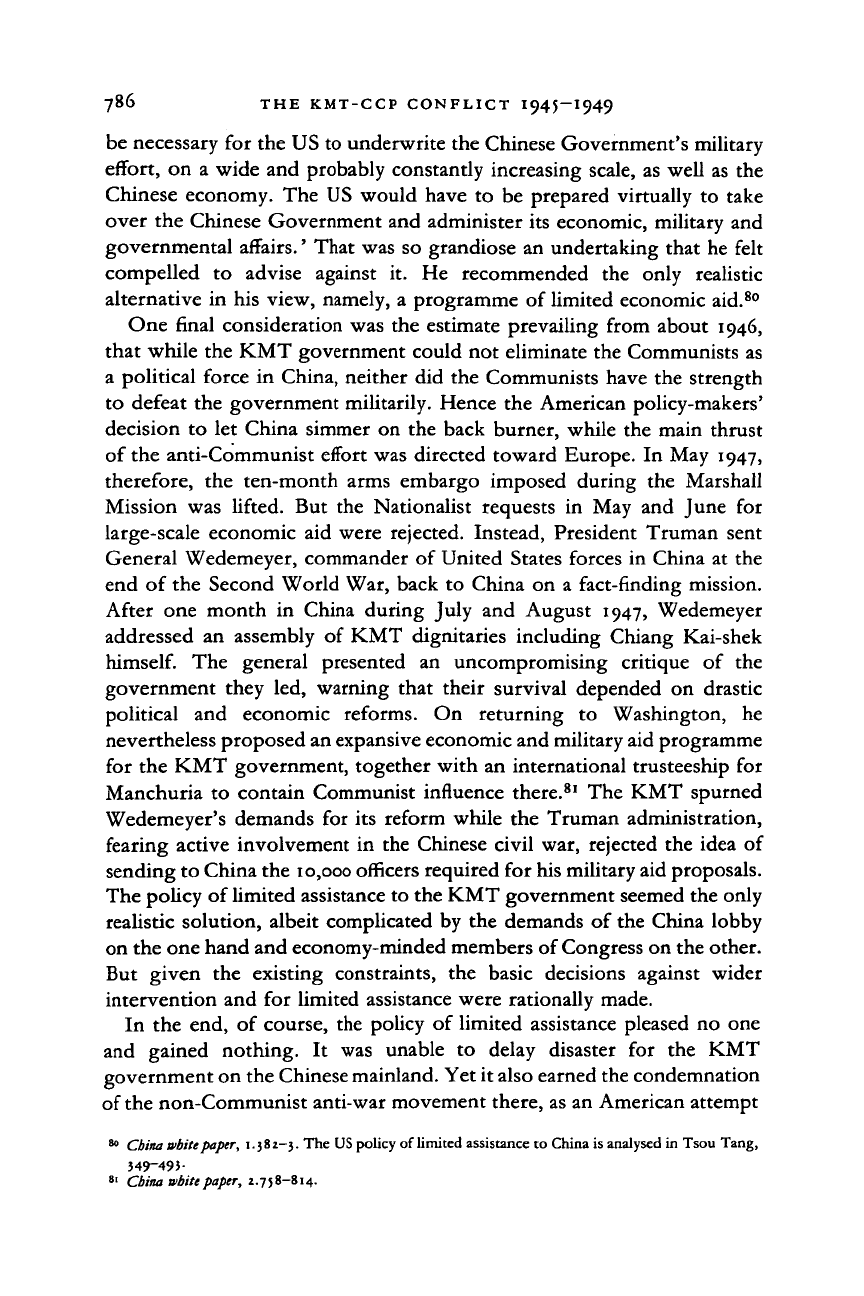
786 THE KMT-CCP CONFLICT I945-I949
be necessary for the US to underwrite the Chinese Government's military
effort, on a wide and probably constantly increasing scale, as well as the
Chinese economy. The US would have to be prepared virtually to take
over the Chinese Government and administer its economic, military and
governmental affairs.' That was so grandiose an undertaking that he felt
compelled
to
advise against
it. He
recommended
the
only realistic
alternative in his view, namely, a programme of limited economic aid.
80
One final consideration was the estimate prevailing from about 1946,
that while the KMT government could not eliminate the Communists as
a political force in China, neither did the Communists have the strength
to defeat the government militarily. Hence the American policy-makers'
decision to let China simmer on the back burner, while the main thrust
of the anti-Communist effort was directed toward Europe. In May 1947,
therefore, the ten-month arms embargo imposed during the Marshall
Mission was lifted. But the Nationalist requests
in
May and June
for
large-scale economic aid were rejected. Instead, President Truman sent
General Wedemeyer, commander of United States forces in China at the
end of the Second World War, back to China on
a
fact-finding mission.
After one month
in
China during July and August 1947, Wedemeyer
addressed an assembly
of
KMT dignitaries including Chiang Kai-shek
himself.
The
general presented
an
uncompromising critique
of the
government they led, warning that their survival depended
on
drastic
political
and
economic reforms.
On
returning
to
Washington,
he
nevertheless proposed an expansive economic and military aid programme
for the KMT government, together with an international trusteeship for
Manchuria to contain Communist influence there.
81
The KMT spurned
Wedemeyer's demands for its reform while the Truman administration,
fearing active involvement in the Chinese civil war, rejected the idea of
sending to China the 10,000 officers required for his military aid proposals.
The policy of limited assistance to the KMT government seemed the only
realistic solution, albeit complicated by the demands of the China lobby
on the one hand and economy-minded members of Congress on the other.
But given
the
existing constraints,
the
basic decisions against wider
intervention and for limited assistance were rationally made.
In the end, of course, the policy of limited assistance pleased no one
and gained nothing.
It
was unable
to
delay disaster
for the
KMT
government on the Chinese mainland. Yet it also earned the condemnation
of the non-Communist anti-war movement there, as an American attempt
80
China
white paper, 1.382-3. The
US
policy of limited assistance to China is analysed in Tsou Tang,
349-493-
81
China
white
paper,
2.758-814.
Cambridge Histories Online © Cambridge University Press, 2008
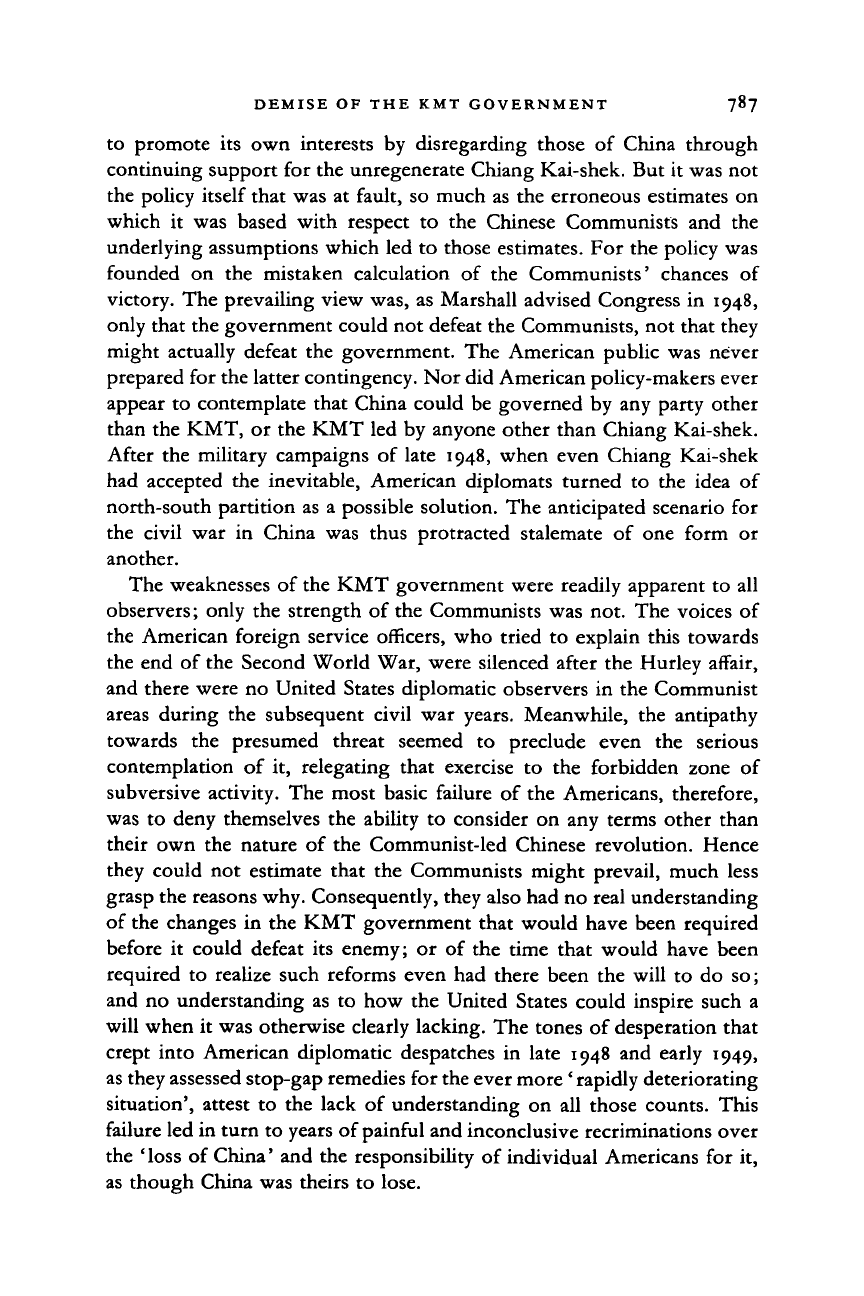
DEMISE OF THE KMT GOVERNMENT 787
to promote its own interests by disregarding those of China through
continuing support for the unregenerate Chiang Kai-shek. But it was not
the policy itself that was at fault, so much as the erroneous estimates on
which it was based with respect to the Chinese Communists and the
underlying assumptions which led to those estimates. For the policy was
founded on the mistaken calculation of the Communists' chances of
victory. The prevailing view was, as Marshall advised Congress in 1948,
only that the government could not defeat the Communists, not that they
might actually defeat the government. The American public was never
prepared for the latter contingency. Nor did American policy-makers ever
appear to contemplate that China could be governed by any party other
than the KMT, or the KMT led by anyone other than Chiang Kai-shek.
After the military campaigns of late 1948, when even Chiang Kai-shek
had accepted the inevitable, American diplomats turned to the idea of
north-south partition as a possible solution. The anticipated scenario for
the civil war in China was thus protracted stalemate of one form or
another.
The weaknesses of the KMT government were readily apparent to all
observers; only the strength of the Communists was not. The voices of
the American foreign service officers, who tried to explain this towards
the end of the Second World War, were silenced after the Hurley affair,
and there were no United States diplomatic observers in the Communist
areas during the subsequent civil war years. Meanwhile, the antipathy
towards the presumed threat seemed to preclude even the serious
contemplation of it, relegating that exercise to the forbidden zone of
subversive activity. The most basic failure of the Americans, therefore,
was to deny themselves the ability to consider on any terms other than
their own the nature of the Communist-led Chinese revolution. Hence
they could not estimate that the Communists might prevail, much less
grasp the reasons why. Consequently, they also had no real understanding
of the changes in the KMT government that would have been required
before it could defeat its enemy; or of the time that would have been
required to realize such reforms even had there been the will to do so;
and no understanding as to how the United States could inspire such a
will when it was otherwise clearly lacking. The tones of desperation that
crept into American diplomatic despatches in late 1948 and early 1949,
as they assessed stop-gap remedies for the ever more' rapidly deteriorating
situation', attest to the lack of understanding on all those counts. This
failure led in turn to years of painful and inconclusive recriminations over
the 'loss of China' and the responsibility of individual Americans for it,
as though China was theirs to lose.
Cambridge Histories Online © Cambridge University Press, 2008
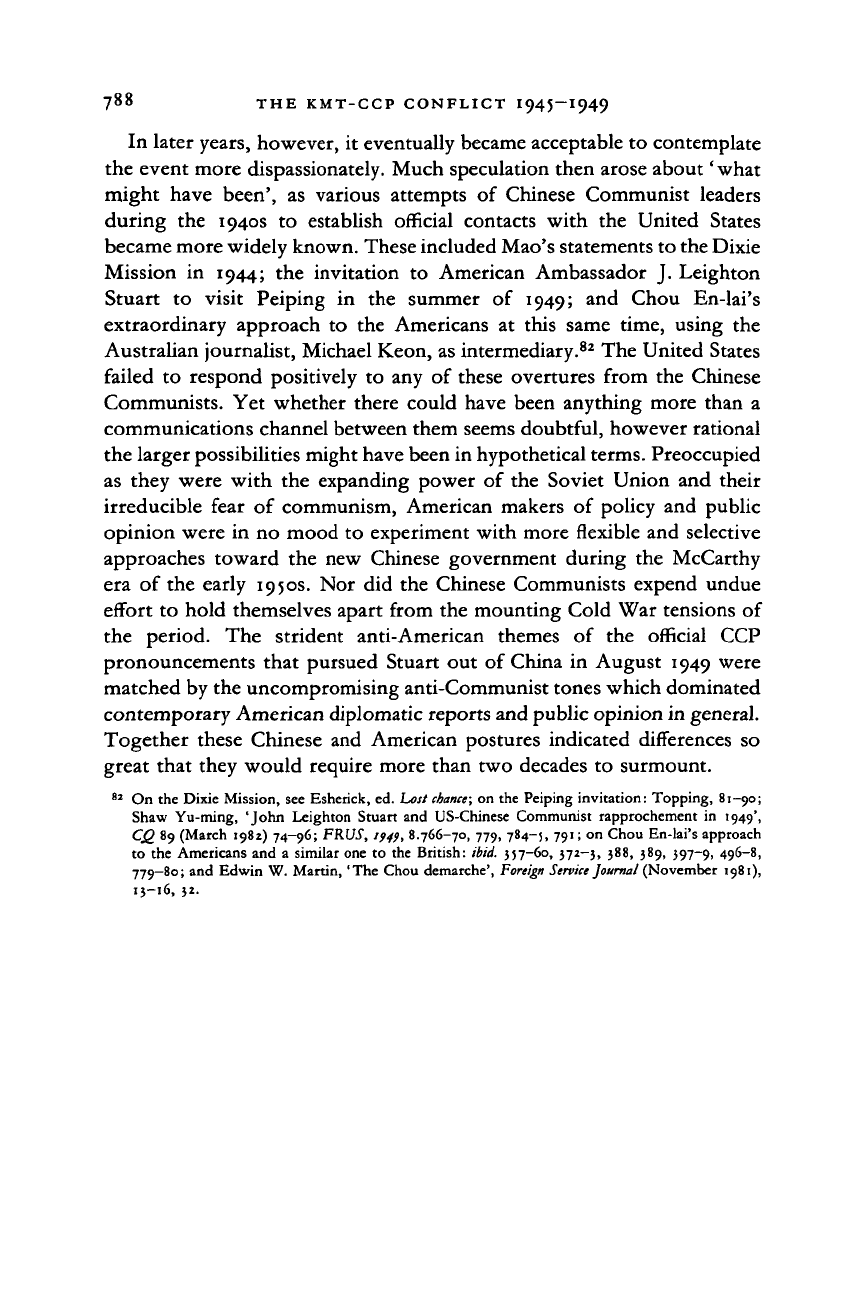
THE KMT-CCP CONFLICT
I945
—1949
In later years, however,
it
eventually became acceptable to contemplate
the event more dispassionately. Much speculation then arose about' what
might have been',
as
various attempts
of
Chinese Communist leaders
during
the
1940s
to
establish official contacts with
the
United States
became more widely known. These included Mao's statements to the Dixie
Mission
in
1944;
the
invitation
to
American Ambassador
J.
Leighton
Stuart
to
visit Peiping
in the
summer
of
1949;
and
Chou En-lai's
extraordinary approach
to the
Americans
at
this same time, using
the
Australian journalist, Michael Keon, as intermediary.
82
The United States
failed
to
respond positively
to
any
of
these overtures from the Chinese
Communists. Yet whether there could have been anything more than
a
communications channel between them seems doubtful, however rational
the larger possibilities might have been in hypothetical terms. Preoccupied
as they were with
the
expanding power
of
the Soviet Union and their
irreducible fear
of
communism, American makers
of
policy and public
opinion were
in
no mood
to
experiment with more flexible and selective
approaches toward
the
new Chinese government during
the
McCarthy
era
of
the early 1950s. Nor did the Chinese Communists expend undue
effort
to
hold themselves apart from the mounting Cold War tensions of
the period.
The
strident anti-American themes
of the
official
CCP
pronouncements that pursued Stuart out
of
China
in
August 1949 were
matched by the uncompromising anti-Communist tones which dominated
contemporary American diplomatic reports and public opinion in general.
Together these Chinese and American postures indicated differences
so
great that they would require more than two decades
to
surmount.
82
On the Dixie Mission, see Esherick, ed. Lost
chance;
on the Peiping invitation: Topping, 81-90;
Shaw Yu-ming, 'John Leighton Stuart and US-Chinese Communist rapprochement
in
1949',
CQ 89 (March 1982) 74-96; FRUS,
1949,
8.766-70, 779, 784-5, 791; on Chou En-lai's approach
to the Americans and
a
similar one
to
the British:
ibid.
357-60,
372-3,
388, 389, 397-9, 496-8,
779-80; and Edwin W. Martin, 'The Chou demarche',
Foreign Service Journal
(November 1981),
13-16, 32.
Cambridge Histories Online © Cambridge University Press, 2008
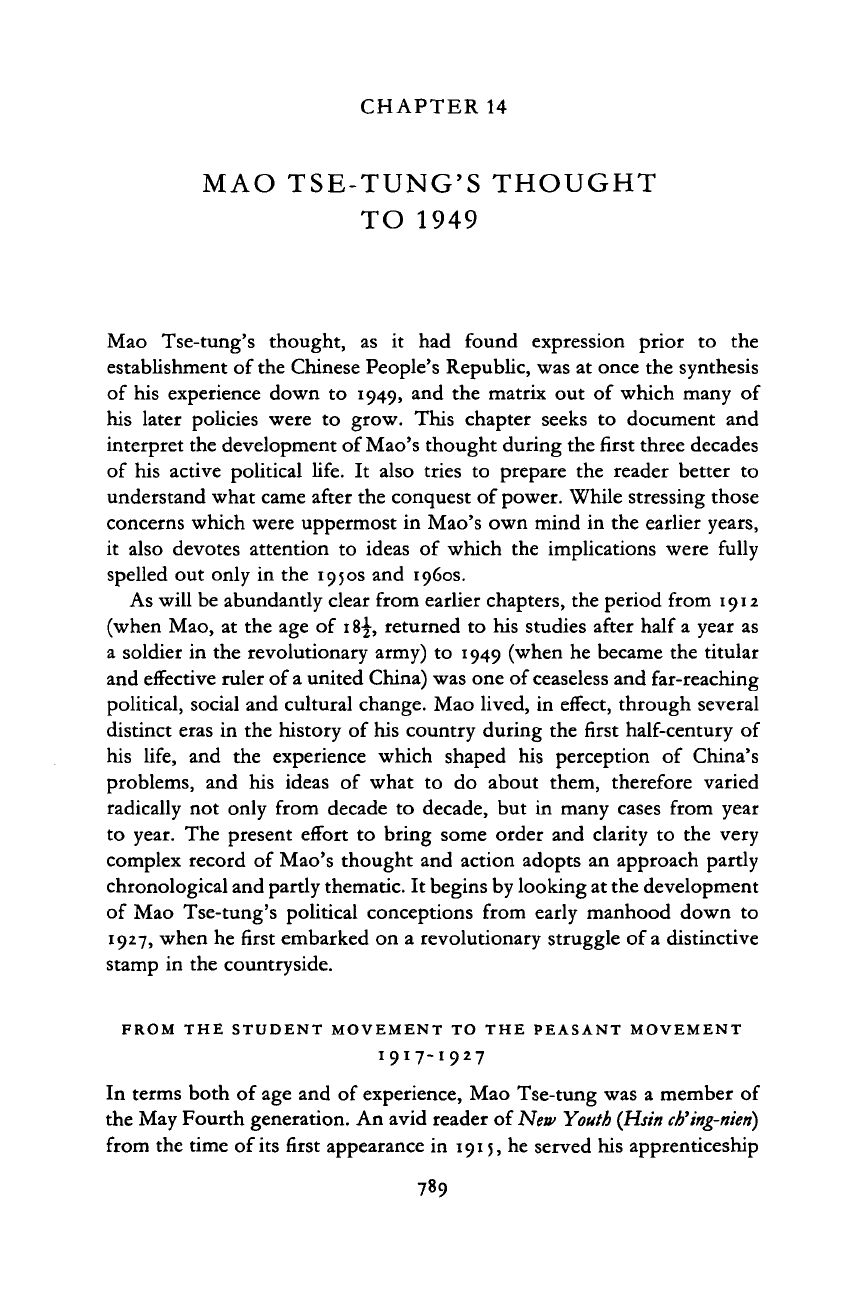
CHAPTER
14
MAO TSE-TUNG'S THOUGHT
TO 1949
Mao Tse-tung's thought,
as it had
found expression prior
to the
establishment of the Chinese People's Republic, was at once the synthesis
of his experience down
to
1949, and
the
matrix
out of
which many
of
his later policies were
to
grow. This chapter seeks
to
document
and
interpret the development of Mao's thought during the first three decades
of his active political life.
It
also tries
to
prepare
the
reader better
to
understand what came after the conquest of power. While stressing those
concerns which were uppermost
in
Mao's own mind
in
the earlier years,
it also devotes attention
to
ideas
of
which
the
implications were fully
spelled out only
in
the 1950s and 1960s.
As will be abundantly clear from earlier chapters, the period from 1912
(when Mao,
at
the age
of
18^, returned
to
his studies after half a year
as
a soldier
in
the revolutionary army)
to
1949 (when he became the titular
and effective ruler of
a
united China) was one of ceaseless and far-reaching
political, social and cultural change. Mao lived,
in
effect, through several
distinct eras
in
the history
of
his country during the first half-century
of
his life,
and the
experience which shaped
his
perception
of
China's
problems,
and his
ideas
of
what
to do
about them, therefore varied
radically
not
only from decade
to
decade,
but in
many cases from year
to year. The present effort
to
bring some order and clarity
to the
very
complex record
of
Mao's thought and action adopts
an
approach partly
chronological and partly thematic. It begins by looking at the development
of Mao Tse-tung's political conceptions from early manhood down
to
1927,
when he first embarked on
a
revolutionary struggle of a distinctive
stamp
in
the countryside.
FROM THE STUDENT MOVEMENT
TO
THE PEASANT MOVEMENT
I917-I927
In terms both
of
age and
of
experience, Mao Tse-tung was
a
member of
the May Fourth generation. An avid reader of New
Youth (Hsin ch'ing-nien)
from the time of its first appearance in 1915, he served his apprenticeship
789
Cambridge Histories Online © Cambridge University Press, 2008
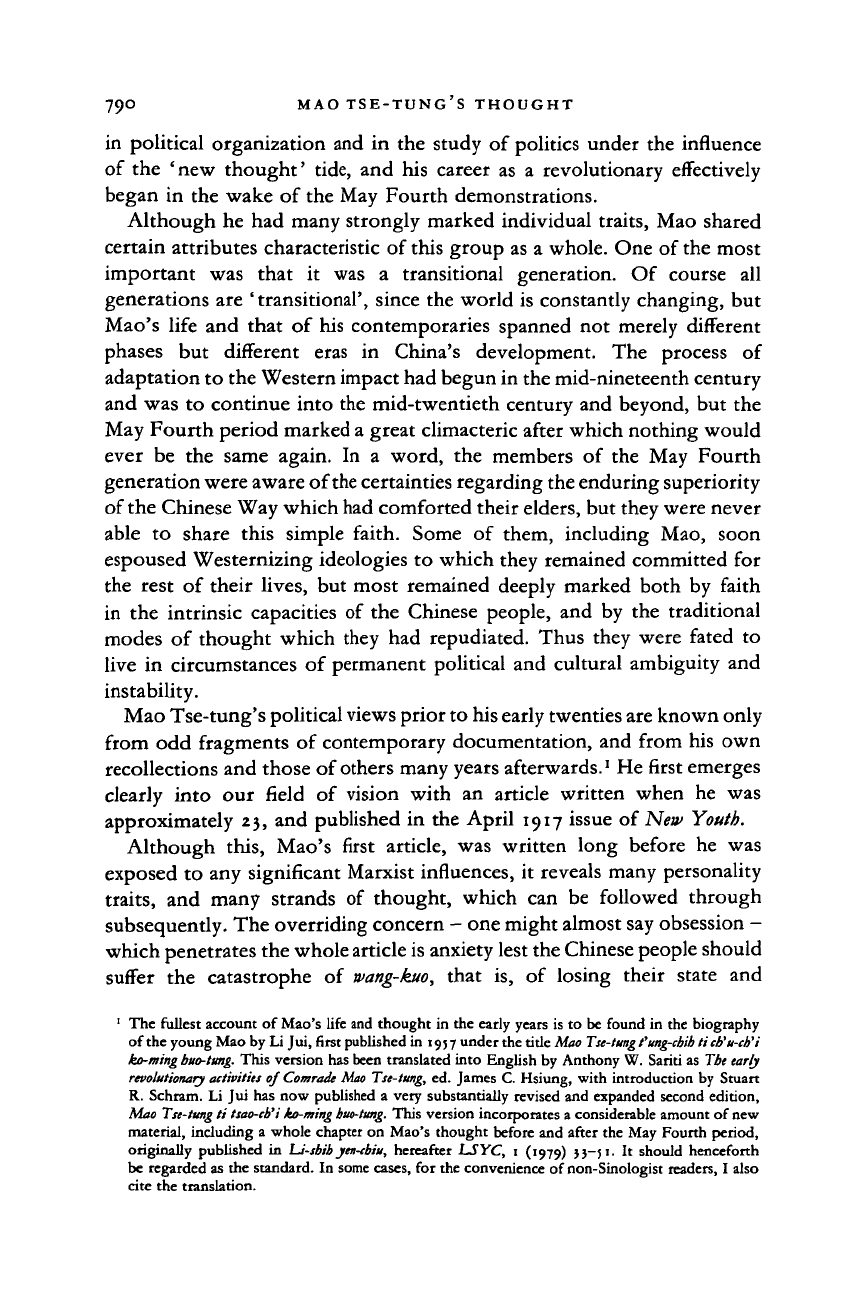
79° MAO TSE-TUNG'S THOUGHT
in political organization and in the study of politics under the influence
of the 'new thought' tide, and his career as a revolutionary effectively
began in the wake of the May Fourth demonstrations.
Although he had many strongly marked individual traits, Mao shared
certain attributes characteristic of this group as a whole. One of the most
important was that it was a transitional generation. Of course all
generations are 'transitional', since the world is constantly changing, but
Mao's life and that of his contemporaries spanned not merely different
phases but different eras in China's development. The process of
adaptation to the Western impact had begun in the mid-nineteenth century
and was to continue into the mid-twentieth century and beyond, but the
May Fourth period marked a great climacteric after which nothing would
ever be the same again. In a word, the members of the May Fourth
generation were aware of
the
certainties regarding the enduring superiority
of the Chinese Way which had comforted their elders, but they were never
able to share this simple faith. Some of them, including Mao, soon
espoused Westernizing ideologies to which they remained committed for
the rest of their lives, but most remained deeply marked both by faith
in the intrinsic capacities of the Chinese people, and by the traditional
modes of thought which they had repudiated. Thus they were fated to
live in circumstances of permanent political and cultural ambiguity and
instability.
Mao Tse-tung's political views prior to his early twenties are known only
from odd fragments of contemporary documentation, and from his own
recollections and those of others many years afterwards.
1
He first emerges
clearly into our field of vision with an article written when he was
approximately 23, and published in the April 1917 issue of New Youth.
Although this, Mao's first article, was written long before he was
exposed to any significant Marxist influences, it reveals many personality
traits,
and many strands of thought, which can be followed through
subsequently. The overriding concern - one might almost say obsession -
which penetrates the whole article is anxiety lest the Chinese people should
suffer the catastrophe of
wang-kuo,
that is, of losing their state and
1
The fullest account of Mao's life and thought in the early years is to be found in the biography
of
the
young Mao by Li Jui, first published in
1957
under the title
Mao
Tse-tung
t'uag-cbib
ticb'u-cb'i
ka-ming
buo-tung.
This version has been translated into English by Anthony W. Sariti as
The
early
revolutionary
activities
of
Comrade
Mao
Tse-tung,
ed. James C. Hsiung, with introduction by Stuart
R. Schram. Li Jui has now published a very substantially revised and expanded second edition,
Mao
Tse-tung
ti
tsao-cb'i
ko-ming
buo-tung.
This version incorporates a considerable amount of new
material,
including a whole chapter on Mao's thought before and after the May Fourth period,
originally
published in U-sbibjen-tbiu, hereafter LSYC, 1 (1979)
33-51.
It should henceforth
be
regarded as the standard. In some
cases,
for the convenience of
non-Sinologist
readers,
I also
cite
the translation.
Cambridge Histories Online © Cambridge University Press, 2008
